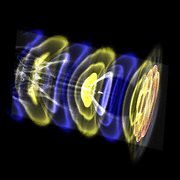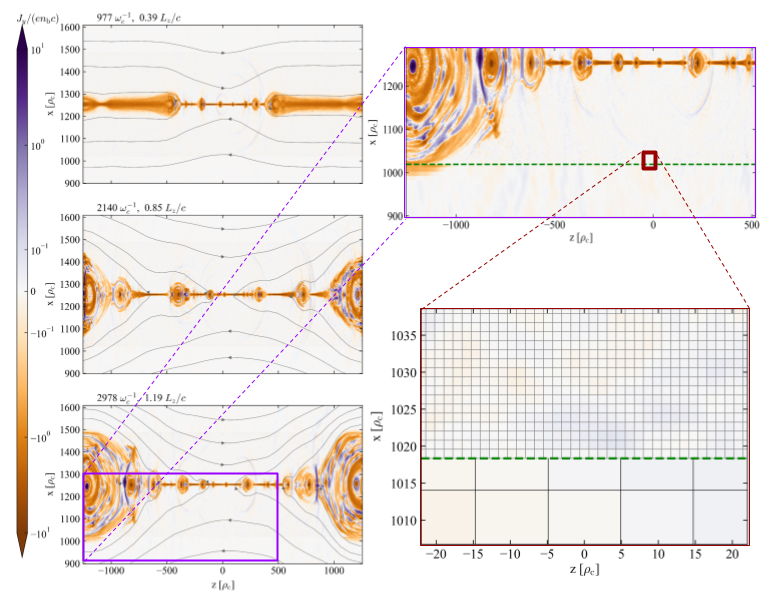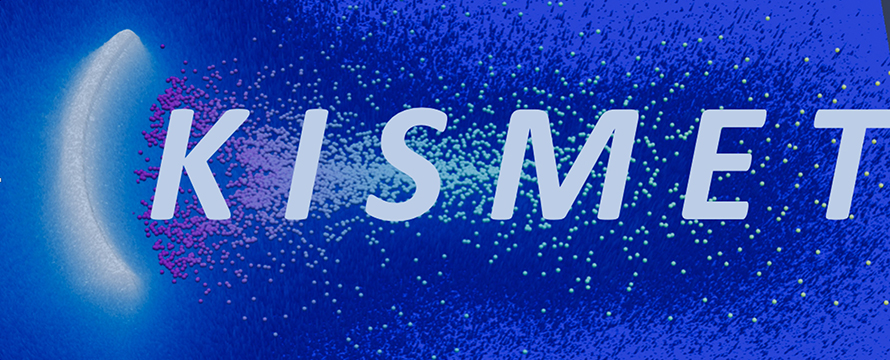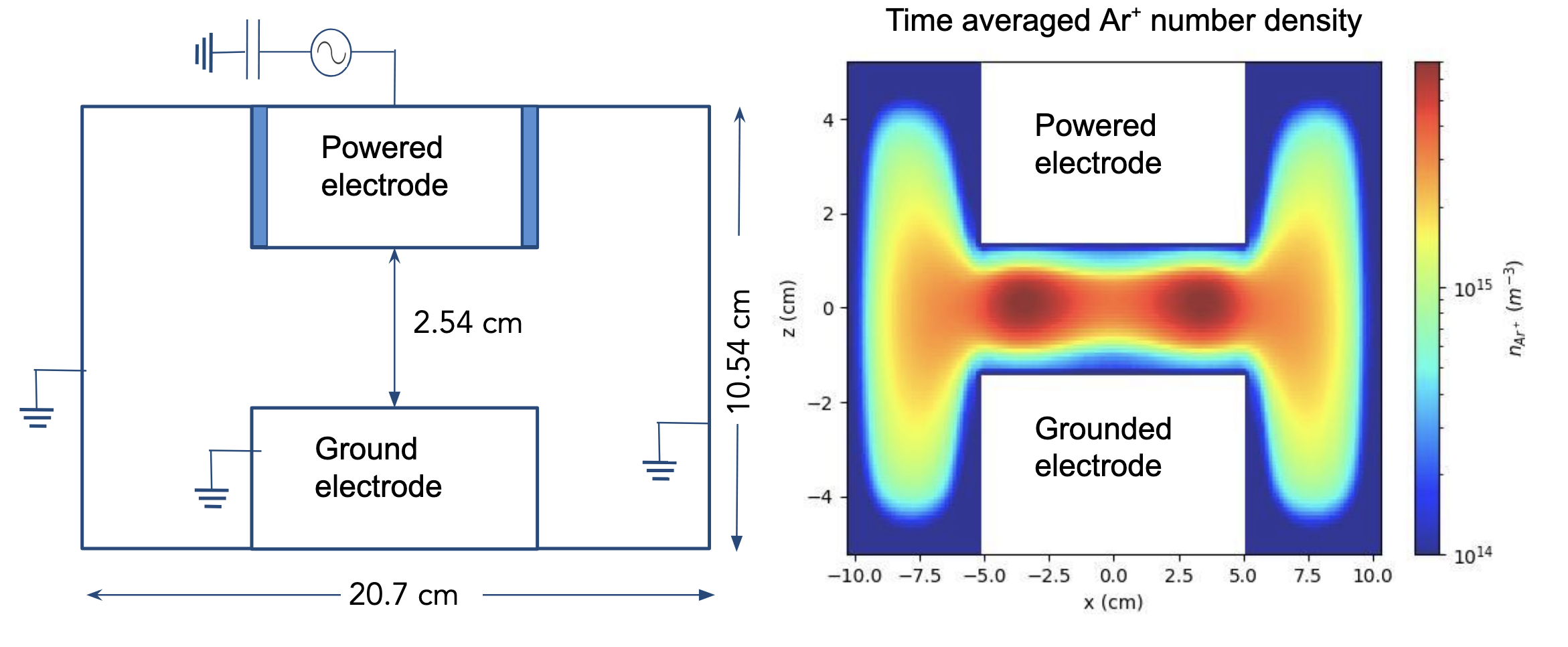
Overview |
AMReX |
People |
Publications |
Plasmas
CCSE Members of the Plasma Development Team
|
Accelerator Modeling with WarpX

|
WarpX is an accelerator modeling code for the exascale being developed as part of DOE's Exascale Computing Program.
CCSE researchers contribute to the core AMReX-based infrastructure for WarpX, and the implementation of
sophisticated mesh refinement algorithms. Ongoing work includes extension of WarpX to work efficiently
on hybrid CPU/GPU platforms.
The official ECP project page is here. The WarpX project is also a member of the NERSC NESAP-for-ECP program. The project is led by Jean-Luc Vay of LBL's Applied Physics and Accelerator Technologies Division. More information about the WarpX software can be found at https://ecp-warpx.github.io/ |
Astrophysical Plasma
Relativistic magnetic reconnection is a non-ideal plasma process that is a source of non-thermal particle acceleration in many high-energy astrophysical systems. Particle-in-cell (PIC) methods are commonly used for simulating reconnection from first principles. We applied mesh refinement to 2D reconnection simulations to efficiently model the inherent disparity in length-scales. We used the ultrahigh-order Pseudo-Spectral Analytical Time-Domain (PSATD) Maxwell solver to analyze how its use can mitigate the numerical dispersion that occurs with the finite-difference time-domain (FDTD) (or ``Yee'') method. Absorbing layers are introduced at the coarse-fine interface to eliminate spurious effects that occur with mesh refinement. We also study how damping the electromagnetic fields and current density in the absorbing layer can help prevent the non-physical accumulation of charge and current density at the coarse-fine interface.

For more information, contact Revathi Jambunathan.
Collaboration for Advanced Modeling of Particle Accelerators

|
The SciDAC CAMPA project brings together accelerator physicists and computational scientists from multiple institutes to develop an integrated community ecosystem of HPC tools for accelerator and beam physics modeling. These tools will be the building blocks for virtual twin accelerator simulations with tunability from ultrafast to ultraprecise predictions. |
Kinetic Inertial Fusion Energy Simulations

|
As part of the SciDAC KISMET collaboration on Kinetic IFE (Inertial Fusion Energy) Simulation at Multiscale with Exascale Technology, we have been improving the WarpX code to study problems of critical importance to IFE: laser-plasma instabilities, laser absorption and transport, and hostspot physics. WarpX has been extended to support implicit PIC with GMRES solver and preconditioner provided by AMReX. |
Plasma-Assisted Semiconductor Chip Fabrication

For more information, contact Revathi Jambunathan.
Publications
 R. Jambunathan, H. Jones, L. Corrales, H. Klion, M. Rowan, A. Myers, W. Zhang, and J.-L. Vay
Application of mesh refinement to relativistic magnetic reconnection
Physics of Plasmas , January 2025
[arxiv]
[doi]
R. Jambunathan, H. Jones, L. Corrales, H. Klion, M. Rowan, A. Myers, W. Zhang, and J.-L. Vay
Application of mesh refinement to relativistic magnetic reconnection
Physics of Plasmas , January 2025
[arxiv]
[doi]
 H. Klion, R. Jambunathan, M. E. Rowan, E. Yang, D. Willcox, J.-L. Vay, R. Lehe, A. Myers, A. Huebl, W. Zhang,
Particle-in-Cell Simulations of Relativistic Magnetic Reconnection with Advanced Maxwell Solver Algorithms,
The Astrophysical Journal, 925, 1, 2023.
[arxiv]
[doi]
H. Klion, R. Jambunathan, M. E. Rowan, E. Yang, D. Willcox, J.-L. Vay, R. Lehe, A. Myers, A. Huebl, W. Zhang,
Particle-in-Cell Simulations of Relativistic Magnetic Reconnection with Advanced Maxwell Solver Algorithms,
The Astrophysical Journal, 925, 1, 2023.
[arxiv]
[doi]
 Luca Fedeli, Axel Huebl, France Boillod-Cerneux, Thomas Clark, Kevin Gott, Conrad Hillairet,
Stephan Jaure, Adrien Leblanc, Rémi Lehe, Andrew Myers, Christelle Piechurski, Mitsuhisa Sato,
Neil Zaïm, Weiqun Zhang, Jean-Luc Vay, Henri Vincenti,
Pushing the frontier in the design of laser-based electron accelerators with groundbreaking
mesh-refined particle-in-cell simulations on exascale-class supercomputers,
SC '22: Proceedings of the International Conference on High Performance Computing, Networking, Storage and Analysis,
November 2022, Article No.: 3, Pages 1–12
[doi]
Luca Fedeli, Axel Huebl, France Boillod-Cerneux, Thomas Clark, Kevin Gott, Conrad Hillairet,
Stephan Jaure, Adrien Leblanc, Rémi Lehe, Andrew Myers, Christelle Piechurski, Mitsuhisa Sato,
Neil Zaïm, Weiqun Zhang, Jean-Luc Vay, Henri Vincenti,
Pushing the frontier in the design of laser-based electron accelerators with groundbreaking
mesh-refined particle-in-cell simulations on exascale-class supercomputers,
SC '22: Proceedings of the International Conference on High Performance Computing, Networking, Storage and Analysis,
November 2022, Article No.: 3, Pages 1–12
[doi]
 Severin Diederichs, Carlo Benedetti, Axel Huebl, Remi Lehe, Andrew Myers,
Alexander Sinn, Jean-Luc Vay, Weiqun Zhang, Maxence Thevenet,
HiPACE++: a portable, 3D quasi-static Particle-in-Cell code,
Computer Physics Communications, 278, 108421, 2022.
[link][arXiv]
Severin Diederichs, Carlo Benedetti, Axel Huebl, Remi Lehe, Andrew Myers,
Alexander Sinn, Jean-Luc Vay, Weiqun Zhang, Maxence Thevenet,
HiPACE++: a portable, 3D quasi-static Particle-in-Cell code,
Computer Physics Communications, 278, 108421, 2022.
[link][arXiv]
 Andrew Myers, Ann Almgren, Diana Almorim, John Bell, Luca Fedeli, Lixin Ge, Kevin Gott, David Grote, Mark Hogan,
Axel Huebl, Revathi Jambunathan, Remi Lehe, Cho Ng, Michael Rowan, Olga Shapoval, Maxence Thevenet, Jean-Luc Vay,
Henri Vincenti, Eloise Yang, Neil Zaim, Weiqun Zhang, Yin Zhao, Edoardo Zoni,
Porting WarpX to GPU-accelerated platforms,
Parallel Computing, 2021.
Andrew Myers, Ann Almgren, Diana Almorim, John Bell, Luca Fedeli, Lixin Ge, Kevin Gott, David Grote, Mark Hogan,
Axel Huebl, Revathi Jambunathan, Remi Lehe, Cho Ng, Michael Rowan, Olga Shapoval, Maxence Thevenet, Jean-Luc Vay,
Henri Vincenti, Eloise Yang, Neil Zaim, Weiqun Zhang, Yin Zhao, Edoardo Zoni,
Porting WarpX to GPU-accelerated platforms,
Parallel Computing, 2021.
 J-L Vay, Ann Almgren, LD Amorim, John Bell, L Fedeli, L Ge, K Gott, DP Grote, M Hogan,
A Huebl, R Jambunathan, R Lehe, A Myers, C Ng, M Rowan, O Shapoval,
M Thevenet, H Vincenti, E Yang, N Zaim, W Zhang, Y Zhao and E Zoni
Modeling of a chain of three plasma accelerator stages with the
WarpX electromagnetic PIC code on GPUs,
Physics of Plasmas, 28(2), 2021.
[doi]
J-L Vay, Ann Almgren, LD Amorim, John Bell, L Fedeli, L Ge, K Gott, DP Grote, M Hogan,
A Huebl, R Jambunathan, R Lehe, A Myers, C Ng, M Rowan, O Shapoval,
M Thevenet, H Vincenti, E Yang, N Zaim, W Zhang, Y Zhao and E Zoni
Modeling of a chain of three plasma accelerator stages with the
WarpX electromagnetic PIC code on GPUs,
Physics of Plasmas, 28(2), 2021.
[doi]
 Y. Zhao, R. Lehe, A. Myers, M. Thevenet, A. Huebl, C. B. Schroeder, and J.-L. Vay,
Modeling of emittance growth due to Coulomb collisions in plasma-based accelerators,
Physics of Plasmas, October, 2020.
[doi]
Y. Zhao, R. Lehe, A. Myers, M. Thevenet, A. Huebl, C. B. Schroeder, and J.-L. Vay,
Modeling of emittance growth due to Coulomb collisions in plasma-based accelerators,
Physics of Plasmas, October, 2020.
[doi]
 J-L Vay, Ann Almgren, LD Amorim, John Bell, L Ge, K Gott, DP Grote, M Hogan,
A Huebl, R Jambunathan, R Lehe, A Myers, C Ng, J Park, M Rowan, O Shapoval,
M Thevenet, W Zhang, Y Zhao, and E Zoni
Toward the modeling of chains of plasma accelerator stages with WarpX,
Journal of Physics: Conference Series, 1596, 1, 012059, 2020
J-L Vay, Ann Almgren, LD Amorim, John Bell, L Ge, K Gott, DP Grote, M Hogan,
A Huebl, R Jambunathan, R Lehe, A Myers, C Ng, J Park, M Rowan, O Shapoval,
M Thevenet, W Zhang, Y Zhao, and E Zoni
Toward the modeling of chains of plasma accelerator stages with WarpX,
Journal of Physics: Conference Series, 1596, 1, 012059, 2020
 F. Alexander, A. Almgren, J. Bell, A. Bhattacharjee, J. Chen, P. Colella, D. Daniel,
J. DeSlippe, L. Diachin, E. Draeger, A. Dubey, T. Dunning, T. Evans, I. Foster,
M. Francois, T. Germann, M. Gordon, S. Habib, M. Halappanavar, S. Hamilton, W. Hart,
Z. Huang, A. Hungerford, D. Kasen, P. Kent, T. Kolev, D. Kothe, A. Kronfeld, Y. Luo,
P. Mackenzie, D. McCallen, B. Messer, S. Mniszewski, C. Oehmen, A. Perazzo, D. Perez,
D. Richard, W. Rider, R. Rieben, K. Roche, A. Siegel, M. Sprague, C. Steefel, R. Stevens,
M. Syamlal, M. Taylor, J. Turner, J.-L. Vay, A. Voter, T. Windus and K. Yelick,
Exascale applications: skin in the game,
Phil. Trans. R. Soc. A, 2020.
[doi].
F. Alexander, A. Almgren, J. Bell, A. Bhattacharjee, J. Chen, P. Colella, D. Daniel,
J. DeSlippe, L. Diachin, E. Draeger, A. Dubey, T. Dunning, T. Evans, I. Foster,
M. Francois, T. Germann, M. Gordon, S. Habib, M. Halappanavar, S. Hamilton, W. Hart,
Z. Huang, A. Hungerford, D. Kasen, P. Kent, T. Kolev, D. Kothe, A. Kronfeld, Y. Luo,
P. Mackenzie, D. McCallen, B. Messer, S. Mniszewski, C. Oehmen, A. Perazzo, D. Perez,
D. Richard, W. Rider, R. Rieben, K. Roche, A. Siegel, M. Sprague, C. Steefel, R. Stevens,
M. Syamlal, M. Taylor, J. Turner, J.-L. Vay, A. Voter, T. Windus and K. Yelick,
Exascale applications: skin in the game,
Phil. Trans. R. Soc. A, 2020.
[doi].
 J.-L. Vay, A. Almgren, J. Bell, L. Ge, D. P. Grote, M. Hogan, O. Kononenko, R. Lehe, A. Myers, C. Ng, J. Park, R. Ryne, O. Shapoval, M. Thevenet, W. Zhang
"Warp-X: a new exascale computing platform for beam-plasma simulations,"
Nuclear Instruments and Methods in Physics Research Section A:
Accelerators, Spectrometers, Detectors and Associated Equipment,
2018 [arxiv]
J.-L. Vay, A. Almgren, J. Bell, L. Ge, D. P. Grote, M. Hogan, O. Kononenko, R. Lehe, A. Myers, C. Ng, J. Park, R. Ryne, O. Shapoval, M. Thevenet, W. Zhang
"Warp-X: a new exascale computing platform for beam-plasma simulations,"
Nuclear Instruments and Methods in Physics Research Section A:
Accelerators, Spectrometers, Detectors and Associated Equipment,
2018 [arxiv]